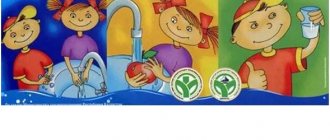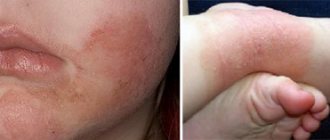Rotavirus in a child
Rotavirus in children: symptoms, treatment, prevention.
Rotavirus infection
- an acute infectious disease with fecal-oral transmission, characterized by damage to the gastrointestinal tract such as gastroenteritis with the development of dehydration syndrome (dehydration).
Rotavirus is the leading cause of gastroenteritis in children under 5 years of age. .In Russia it is most often recorded in the winter-spring period.
Causes of infection:
The causative agent is rotavirus, belongs to the family
RNA viruses. Types 1 - 4, 8 and 9 of the virus are considered infectious to humans.
The source of infection is a person (patient or virus transmitter). The number of asymptomatic carriers of the virus among children can reach 5–7%. The virus is able to remain viable in the external environment for several months, is stable at low temperatures, and quickly dies when heated.
In the Russian Federation as a whole, the proportion of sick children under 1 year of age is 20.6%, and 44.7% at the age of 1–2 years. By the age of 2, almost every child experiences rotavirus infection at least once, and more than 2/3 become ill again. Given its high contagiousness (infectiousness), it is a common cause of outbreaks in organized groups (kindergarten, school) and hospitals.
The mechanism of transmission
of rotavirus
is fecal-oral: it is realized through food, water and household contact. Given the extremely high contagiousness of rotavirus and the resistance of the pathogen to household chemicals, even very strict hygiene measures (including washing hands after each contact with a sick person) can often be ineffective. The incubation period is only a few days - on average from 1 to 3 days.
Clinical picture
The main symptoms of rotavirus gastroenteritis are general intoxication (fever, lethargy, vomiting, headache) and changes in the gastrointestinal tract: abdominal pain, frequent loose, watery stools. Rotavirus gastroenteritis is characterized by two variants of onset of the disease: acute (about 90% of patients), when all the main symptoms appear on the 1st day of the disease, and subacute, when 1-2 symptoms (usually abdominal pain and intoxication) on the 2-3rd day illnesses include diarrhea, vomiting, fever.
General infectious syndrome.
Most cases of rotavirus infection begin acutely with an increase in temperature to febrile levels (38.0 degrees) or even hyperthermia, but the duration of fever, despite its severity, rarely exceeds 2-4 days. Fever is accompanied by symptoms of intoxication: weakness, lethargy, decreased appetite, up to the development of anorexia and adynamia in severe forms of the disease. In older children, with mild forms, the disease can occur against a background of low-grade fever with moderate symptoms of intoxication or their absence.
Syndrome of local changes (gastritis, gastroenteritis and/or enteritis).
One of the first, and often the leading, manifestations of rotavirus infection is vomiting. It can occur simultaneously with diarrhea or precede it, and be repeated or repeated over 1-2 days. Damage to the gastrointestinal tract occurs as gastroenteritis or (less commonly) enteritis. Diarrheal syndrome due to rotavirus infection is one of the most important and constant manifestations, in some cases determining the clinical picture of the disease. The stool is copious, watery, foamy, yellow in color, without visible pathological impurities, or with a small amount of clear mucus, sometimes there is a characteristic sour smell of stool. The frequency of stools on average does not exceed 4–5 times a day, but in young children it can reach 15–20 times. The duration of diarrhea on average ranges from 3 to 7 days, but can persist for a longer time (up to 10-14 days, more often in young children). Rotavirus infection is characterized by a combination of diarrhea and flatulence, which are most pronounced in children of the first year of life. Abdominal pain syndrome due to rotavirus infection appears at the onset of the disease. Abdominal pain of varying severity can be diffuse or localized in the upper half of the abdomen, and episodes of cramping pain can also occur.
Dehydration syndrome.
The severity of rotavirus gastroenteritis is determined by the amount of pathological fluid loss with vomiting and diarrhea and the development of exicosis (dehydration) of I–II, less often II–III degrees. The degree of exicosis in patients depends not only on the severity of pathological losses of fluid and electrolytes, but also on the adequacy of the rehydration therapy (adequate fluid replacement). The development of dehydration is signaled by the following signs: constant thirst, sunken eyes and fontanel, dry skin, sclera and mucous membranes. The skin acquires an earthy-gray tint, lips become bright and dry, skin turgor decreases, and the amount of urine decreases. The most dangerous condition is considered to be the stage of dehydration, in which thirst is replaced by a complete refusal to drink and a pronounced decrease in urination occurs, up to its complete absence.
Syndrome of catarrhal changes.
In 60–70% of patients with rotavirus infection, catarrhal symptoms occur in the upper respiratory tract, which may precede intestinal dysfunction. It is characterized by moderate hyperemia and granularity of the posterior wall of the pharynx, soft palate and palatine arches, nasal congestion, and coughing. However, the presence of catarrhal symptoms in some cases may be due to a concomitant respiratory viral infection, especially during the seasonal rise in incidence.
Extraintestinal complications:
- dehydration
- secondary infection
- possible development of seizures
— improper water regime RVGE can cause cerebral edema, disseminated intravascular coagulation syndrome, acute renal failure and other life-threatening conditions
The most alarming signs! (You need to call an ambulance
)
- marked weakness and lethargy, almost constant sleep or, on the contrary, incessant restlessness
- incessant vomiting
- inability to give a child something to drink
- absence of urination or very rare concentrated urine
- in children under one year of age - retraction of the fontanel
- blood in the stool
Disease prognosis:
The prognosis of the disease with adequate hydration is usually favorable; the duration of the disease rarely exceeds 5-7 days. After rotavirus gastroenteritis, a child may become infected again due to seasonal changes in circulating rotavirus serotypes, but a natural infection may reduce the severity of subsequent infections.
Diagnostics:
Stool ELISA and OKI test (also includes PCR testing for other types of viruses that cause acute intestinal infections, salmonellosis and dysentery)
First aid:
-Drink plenty of small amounts. For this, it is preferable to use specialized saline solutions - Regidron, Regidron - Bio. In the first hours, in order not to provoke vomiting, you can give 1 tsp. or tbsp. every 5 - 10 minutes.
IMPORTANT TO REMEMBER! Depending on age, a child should drink at least 1 - 1.5 liters of water per day. Therefore, especially during the first knocks of the child, you SHOULD continue to give water during sleep, making sure that the child does not choke.
- Place a small child on his side so that in case of an attack of vomiting he does not choke on the vomit.
- Antipyretics - only if the temperature is above 38.5.
- Do not feed for the first 3 hours after vomiting, then in small portions.
Be sure to continue breastfeeding!
— In the acute period, to accelerate the normalization of stool and remove the virus from the body, astringent and adsorbent substances (carbolene, polyphepan, smecta, enterosgel, etc.) are used.
Diet:
When treating intestinal infections that provoke the development of fermentopathy, special attention is paid to diet. Since the development of the pathological process disrupts the activity of a number of digestive enzymes, in particular lactase, during the acute period of the disease, whole milk and dairy products should be excluded from the child’s diet and the intake of foods rich in carbohydrates (sweet fruits, fruit juices, baked goods, legumes) should be limited. culture). Also, during the acute period of illness, it is not allowed to feed children meat, broths, meat products, fatty and fried foods. Food is given to a sick child often, in small portions. The list of permitted foods includes slimy porridges, vegetable purees and soups, white crackers and baked apples.
Breastfeeding in the presence of an intestinal infection is not stopped, since breast milk contains antibodies that neutralize rotavirus and immunoglobulins, which alleviate the course of the disease.
Common mistakes:
- Giving antibiotics. In this case, the culprit is a virus and any antibiotic is completely powerless against it. It will not bring any benefit, it will only increase the likelihood of complications.
- in case of profuse diarrhea, use any antidiarrheal drugs such as loperamide (without consulting a doctor). Taking them can increase intoxication and lengthen the recovery period.
Prevention:
There is specific prevention against rotavirus - vaccination
Vaccination (Rotatec). The course consists of three doses with an administration interval of 4 to 10 weeks. The first vaccine is administered at the age of 6 to 12 weeks. Last administration before 32 weeks of life. (Compatible with any vaccines from the national calendar except BCG)
Besides:
Patients with mild forms of rotavirus infection are isolated at home for 7 days, after which the person who has recovered from the disease can be admitted to an organized group (including children) on the basis of a doctor’s certificate of recovery without additional virological examination.
• Use only boiled water for drinking;
• Thorough hand washing before eating;
• Pre-washing fruits and vegetables with a brush;
• Sufficient thermal processing of food.
Rotavirus infection, rotavirus diarrhea in children
Rotavirus infection is a disease belonging to the group of acute intestinal infections and caused by rotaviruses. Rotaviruses are divided into 5 groups, within which there are subspecies (as a result of this, a child who has had a rotavirus infection does not develop immunity). Children under 3 years of age are most often affected by rotaviruses. Rotaviruses are easily transmitted through food, water, contaminated hands, toys, linen, dishes, etc. That is why the disease spreads quickly in children's institutions. Airborne transmission is also possible. Rotaviruses love low temperatures, so the disease most often spreads in winter and early spring. In addition, rotaviruses are extremely resistant to various environmental factors and persist for a long time in soil, water, and food products.
Rotavirus infection in children: symptoms
The incubation period can vary from 3-5 to 15 days, but more often it is 1-3 days, and sometimes even several hours. The disease begins acutely: high temperature (up to 39-40 degrees C), vomiting, diarrhea. Often, damage to the gastrointestinal tract is combined with respiratory phenomena: swelling of the pharynx, nasal congestion, coughing. Due to frequent bowel movements (from 4-5 to 15-20 times a day) and vomiting, rapid dehydration of the child’s body occurs with the following signs: lethargy, drowsiness, dry skin, pointed facial features. The disease may be accompanied by headache and dizziness.
Call a pediatrician to your home - Markushka clinic.
Rotavirus infection in children: treatment
The most important thing is to restore the water-salt balance ( eliminate dehydration ). For this, the child is given a water-salt solution (0.5 tsp salt and 6 tsp sugar per liter of water) or diluted with ready-made pharmaceutical powder “Regidron”. A good children's doctor is the Markushka clinic.
Under no circumstances should you stop diarrhea with medications like Immodium, otherwise toxins will not be removed from the child’s body.
After the diarrhea stops, a strict diet is necessary for several days: porridge, vegetarian soups, vegetable purees, baked apples with sugar, crackers. Feeding should be frequent and in small portions. Dairy products, meat, and broths should not be given.
The drug “Anaferon for children” is effective: up to 8 doses on the 1st day, then 1 tablet 3 times a day for 5 days. Enterosorbents are used (for example, Smecta), especially from the first hours of illness. Drug therapy should be prescribed by a pediatrician.
Vaccinations for children up to one year old - Markushka Children's Clinic.








